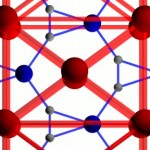Superconductivity is a human-scale manifestation of Quantum Mechanics where the electrons in a material act coherently, like photons in a laser. But whereas photons are bosons, which can exist in the same quantum state, electrons are fermions, which cannot. The “BCS” theory of superconductors solved this conundrum by positing “Cooper pairs” of electrons obeying Bose-Einstein statistics. This led to many experimentally-verified predictions, new ideas (e.g. the Higgs mechanism) and life-saving technologies (MRI).
“Cooper pairs” of electrons obeying Bose-Einstein statistics. This led to many experimentally-verified predictions, new ideas (e.g. the Higgs mechanism) and life-saving technologies (MRI).
Interestingly, not all superconductors obey BCS theory. The growing number of such “unconventional superconductors” include materials with uniquely useful and puzzling properties, including the two superconductor families with the highest confirmed room-pressure critical temperatures (the Cu-based and Fe-based high-temperature superconductors). Current and future applications include energy transmission, storage and generation, high-performance computing, and quantum computing.
In BCS theory, Cooper pairs are singlets, with the spins of the two electrons cancelling each other. This makes conventional superconductivity antagonistic to magnetism, as a net magnetisation would require breaking the Cooper pairs to align the electrons’ spins. For triplet pairing, in contrast, the Cooper pair has a net spin. This opens up the possibility of more complex states combining superconducting and magnetic properties with many potential applications e.g. in superconducting supercomputer spintronics.
In recent years we have obtained evidence, using a combination of muon spin rotation/relaxation (where bunches of artificially-generated muons are implanted in the sample as a sensitive probe of internal magnetic fields) and group-theory based theoretical analyses, of spontaneous magnetic fields in several superconductors whose normal states are non-magnetic [1-4]. In the case of LaNiC2 [1] and LaNiGa2 [2], we have proposed nonunitary triplet pairing. In this case, the spins of different Cooper pairs are aligned with each other, leading to a net magnetisation. This prediction [2] has recently been supported by experiments [5].
Previously-confirmed nonunitary triplet superconductors are ferromagnets [6] i.e., a magnetisation exists above Tc before the superconducting instability sets in. Nonunitary pairing in that case allows the electrons to coexist with that pre-existing magnetisation. In contrast, the unique mechanism whereby the Cooper pairs form and magnetise simultaneously in LaNiC2 [1] and LaNiGa2 [2] is unknown. We hypothesize that LaNiC2 and LaNiGa2 represent a new family of Ni-based unconventional superconductors with pairing driven by ferro-magnetic correlations on the Ni site. Fleshing this out will involve sophisticated field theories treating the Stoner and BCS susceptibilities and order parameters on the same footing and close collaboration with experimentalists.
The successful candidate will be supervised by Dr. J. Quintanilla and fully-integrated in his collaborations with top theorists and experimentalists in the UK, Japan, Germany and China.
Note this is a self-funded PhD project. Candidates must secure the means to fund their maintenance and fees independently. A guide to many funding sources available at university, national and itnernational level is avalialbe here.
[1] AD Hillier, J Quintanilla & R Cywinski, Phys. Rev. Lett. 102, 117007 (2010).
[2] AD Hillier, J Quintanilla, B Mazidian, JF Annett & R Cywinski, Phys. Rev. Lett. 109, 097001 (2012).
[3] RP Singh, AD Hillier, B Mazidian, J Quintanilla, JF Annett, D McK Paul, G Balakrishnan & MR Lees, Phys. Rev. Lett. 112, 107002 (2014).
[4] A Bhattacharyya, DT Adroja, J Quintanilla, AD Hillier, N Kase, AM Strydom & J Akimitsu, Phys. Rev. B 91, 060503(R) (2015).
[5] de Visser, A. in Encyclopedia of Materials: Science and Technology.-2nd ed. (Elsevier, 2010).
[6] A. Sumiyama et al., J. of the Phys. Soc. Japan 84, 013702 (2015).
